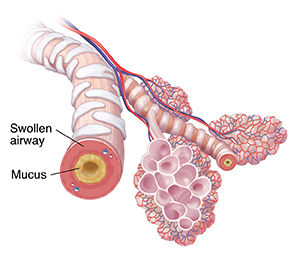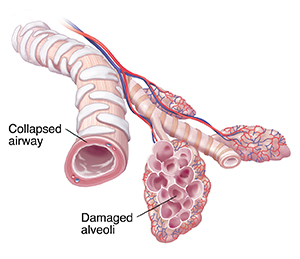COPD: Wheezing and Chest Tightness
Wheezing, chest tightness, and shortness of breath are common symptoms of COPD. Wheezing is a whistling or squeaking sound when you breathe in or out. Chest tightness may feel like it is hard to take a deep breath. Or it may hurt to breathe. It can also make you feel short of breath.
How does COPD cause wheezing and chest tightness?
COPD is a condition that keeps your lungs from working as they should. The lungs’ job is to get air in and out of the body. Inside the lungs, air moves through tubes called airways. In healthy airways, air moves in and out easily. With COPD, lungs and airways become damaged. This damage causes the lining of airways to swell and become clogged with mucus. The airways can also become narrow or even collapse. Then air does not move in and out of the body the way it should. This can lead to wheezing and chest tightness. It can make it harder to take a deep breath.
 |
| Airway with chronic bronchitis. |
 |
| Airway with emphysema. |
Treatment for wheezing and chest tightness
There are treatments that can help with wheezing and chest tightness. These include:
-
Bronchodilators. These medicines help open the airways to improve breathing. You usually take these using an inhaler.
-
Combination medicines. These include a bronchodilator and a steroid. Steroids help reduce swelling and inflammation in the airways.
-
Antibiotics. A respiratory infection can make COPD symptoms worse. Antibiotics are medicines that help treat bacterial infections.
-
Pulmonary rehab (rehabilitation). This program teaches you ways to ease COPD symptoms. You can learn how to exercise and how to save your energy. You can also learn how to eat healthy and how to use better posture. All these things can help you breathe better.
-
Oxygen therapy. When the level of oxygen in the blood is too low, your doctor may prescribe this therapy. Or, when your lungs can’t get enough oxygen to the blood, you may get extra oxygen. Oxygen can be used some of the time. Or it can be used most of the time. Talk with your doctor about when you should use oxygen therapy.
-
Surgery. This may be done for severe symptoms when other treatments have not helped. Surgery removes the most damaged parts of the lungs.
Your doctor will work with you to decide on the best treatment for you.
Self-care tips for wheezing and chest tightness
Here are some things you can do to get relief from your COPD symptoms.
-
Stop smoking. This is the most helpful step you can take to treat COPD. As soon as you quit, your body starts to repair the damage caused by smoking. If you need help quitting, talk with your doctor.
-
Avoid secondhand smoke and other irritants. Try to stay away from smoke, chemicals, fumes, and dust as much as you can. Don’t let anyone smoke in your home or around you. Stay indoors on smoggy days.
-
Prevent lung infections. Having COPD increases your risk for infections. These include the flu, pneumonia, and COVID-19. Get vaccines as directed by your doctor. Stay away from crowded places during cold and flu season. And avoid people who are sick.
-
Wash your hands often. This helps prevent infections. Wash your hands with soap and water for at least 20 seconds. When you can't wash your hands, use hand sanitizer with at least 60% alcohol.
-
Do breathing exercises. Learn how to do belly breathing and pursed-lip breathing. They can help you breathe better. Try to do each exercise for 5 to 10 minutes every day. Or do them as recommended.
-
Don’t be afraid to be active. Being active may make you short of breath. But exercise can strengthen the muscles that help you breathe. Talk with your doctor about safe exercises for you. Ask what type of exercise you can do. And ask how much you can do.
-
Eat small meals throughout the day. Your stomach won’t get as full. Then your lungs will have more room to expand so you can breathe better.
-
Drink plenty of water. This can make mucus thinner and easier to cough up. Ask your doctor how much water you should drink.
-
Take care of your mental health. Being short of breath can cause anxiety. And anxiety can make you breathe faster. This makes shortness of breath worse. Talk to your doctor if you have anxiety, panic attacks, or other mental health concerns. They can suggest treatment options, such as counseling.
When to contact your doctor
Contact your doctor or get medical care right away if you have:
-
A fever of 100.4°F (38°C) or higher, or as directed by your doctor.
-
Symptoms that don’t get better, or that get worse.
-
New symptoms.
Online Medical Reviewer:
Jessica Gotwals RN BSN MPH
Online Medical Reviewer:
Marianne Fraser MSN RN
Date Last Reviewed:
6/1/2025
© 2000-2025 The StayWell Company, LLC. All rights reserved. This information is not intended as a substitute for professional medical care. Always follow your healthcare professional's instructions.